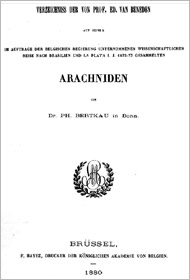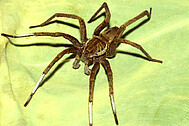Ancylometes – systematics
The type species A. vulpes was described in 1880 by Bertkau as a lycosid, and its familiar belonging and systematics remained rather confuse until recently. The presence of a third claw, the absence of scopulae, and the construction of a nursery web, as well as a habitus and and behaviour resembling Dolomedes and Thalassius, explains its placement in Pisauridae. However, Lehtinen (1967: 214) already transferred Ancylometes (and Cupiennius) to Ctenidae. This was rejected by Schiapelli & Gerschman (1970a: 155), but reinstated by Silva (2003: 32), based on a cladistic analysis with parsimony weighting, for which she used A. bogotensis. Following her Ancylometes appears to be the sister genus to Cupiennius, forming a group basal to the higher ctenids, where the median tarsal claw is still retained. Obviously the similarity of the "fishing spiders" Ancylometes, Dolomedes and Thalassius has independently derived as an adaptation to similar water-rich environments and conditions.
Type species of the genus is A. vulpes Bertkau, 1880, but the type, an immature female collected in Minas Gerais, Brazil, is lost. Höfer & Brescovit (2000) have examined Ancylometes specimens from the type locality Barbacena and considered them congruent to the original description of A. vulpes. The species is considered a junior subjective synonym of Dolomedes concolor Perty, 1833, whose type from Brazil is also lost. Consequently the valid name of the type species is Ancylometes concolor (Perty).
Further is Ancylometes considered to be a senior synonym of Corinoctenus Mello-Leitão, 1939 by Schiapelli & Gerschman (1970a: 165).

 Original description by Bertkau(562 KB)
Original description by Bertkau(562 KB)



